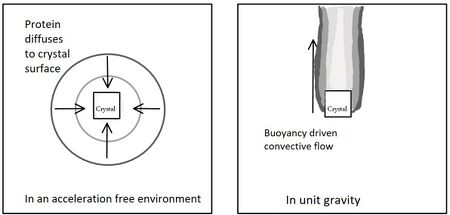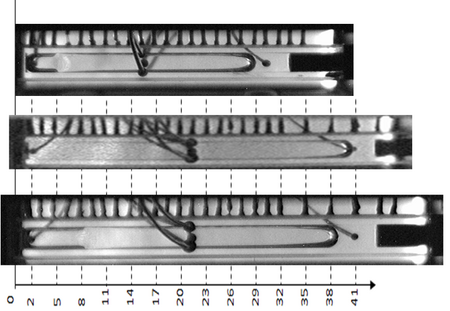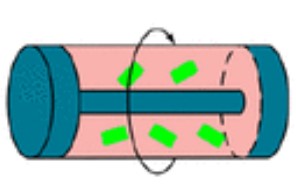Microfluidics vs. Microgravity - Kat. Nilov and Jad Haddad
What is Microgravity?

Microgravity can be defined colloquially and specifically. Generally, microgravity refers to environments that exist with gravitational force less than that of Earth's. Scientifically, microgravity specifies gravitational forces on the magnitude of 10-6 g, where g is the gravitational force on earth (9.8 ms-2). [1] The effects of microgravity are observed when astronauts and objects float freely in space. Heavy objects can move around easily allowing astronauts to move equipment with just their fingertips. This type of environment can be achieved one of two ways; either at a distance of 6x109 km away from the earth surface, or in systems in free fall. The International Space Station pictured in Figure 1. [2] is an object in free fall along the earth orbit, which achieves this low gravity system. The free-fall method can be tricky as slight perturbations in crew movement or outside forces can disturb the system, and result in disfiguration in the system, such as buoyancy driven convection, which can alter the results of an experiment such as protein crystallization. On Earth, some systems have been designed to alleviate systematic disruptions of someone walking around or leaning on a table with equipment that needs to be very steady for crystallization, with the introduction of a counter force (at RPI Crystallization Troy, NY for example). This same level of disruption can skew experiments in microgravitational environments. The main challenges in microgravitational experiments are then the achievement of this system and the stability of it.
Applications of Microgravitational Systems

Microgravity takes advantage of the lack of external force for more equal dispersion of natural forces. Phenomena like buoyancy driven convection, require the presence of gravity. The gravitational separation can be "bypassed" by experimenting on the microscale. Similar to the Reynolds Number, dependent on velocity, the Grashof number is dependent on buoyancy driven flow. To get a small Gr, one can either manipulate gravity or length. Microfluidics can exploit small length scales and achieve small Gr, simulating a microgravitational environment. An area that has really taken advantage of microgravity is protein crystallography.
Protein Crystallography

Often, buoyancy driven flow forces crystals to grow with certain flow constraints. This can result in crystals of lower quality. [4] This problem can be mitigated by implementing systems which avoid the external forces. These systems include microgravity systems as well as microfluidic systems. Microgravity systems allow for the dispersion of crystal growth to be uniform and undisturbed. This is what is speculated to result in high quality crystal growth. This system is imitated by microfluidic devices of small scale. The control of the diffusive crystallization allowing to mimic the microgravity environment, is quantified by the Grashof number. In experiments preformed "on the ground", microwells of depths less than 100 μm can be regarded as microgravitational due to the small Gr number [5] . This small number dictates that natural convection does not impact the growth and that the diffusion in the wells are dominated by Fick's law of diffusion, where the rate of diffusion is proportional to the concentration gradient.
Effects on Heat Transfer

Wickless heat exchangers have been studied by groups at RPI (Rensselaer Polytechnic Institute) in the ISS, where air bubbles have been constrained in quadratic wells with temperature sensors to study the effect gravity and other forces impact heat transfer. This is known as the Constrained Vapor Bubble (CVB) experiment [6] . These studies are meant to guide understanding of heat pipes and eventually assist in optimizing heat exchange design. The unexpected nucleation of new bubbles boiling into the liquid vessel led to new investigations on how capillary flow and surface tension change heat pipe behavior. Such studies have increased understandings of thermodynamics in microgravity systems which are essential for safety assurance with long-term storage of fuel. One particular discovery that came from the CVB experiment is in regard to the Marangoni effect, which describes the mass transfer along an interface between two fluids. The small scale of this experiment helps visualize the changing interfaces of the fluids and microfluidics aids in the insight on how heat exchangers work. These sorts of discoveries can support spaceflight with more efficient cooling systems on the microscale.
Cell and Tissue Studies; Health in Space

Cells and tissue in space have provided understanding of certain biological functions. By studying the impact of microgravity on cell growth or shape, advances can be made on underlying causes of astronaut health decline of muscle strength, bone marrow, and cardiovascular fitness. [7]
The most common effects observed in astronauts is bone resorption. [10] This happens mainly to astronauts who experience long term spaceflight. Astronauts experience a reduction of mechanical stress on the skeletal system. Members of the 84-day Skylab 4 mission lost an average of four percent of bone in that 84-day period. [11] Increased mission length can cause severe bone loss in spite of daily exercise. Cells sense changes in physical forces caused by gravity and respond by bone remodeling. A common effect experienced in the initial hours of space time is Space Adaptation Syndrome, or SAS. This syndrome is often referred to space sickness where the body experiences symptoms, such as nausea, vomiting, vertigo, headaches, and overall malaise. Space sickness usually lasts for no more than 72 hours in which the body then adapts itself to a new physical environment. Another effect experienced in the initial hours of space time is muscle atrophy where muscle mass, strength, and performance are reduced; however, these effects reverse rapidly once astronauts return to Earth.
In order to make relevant conclusions on the impact of gravity on these systems, multiple levels of gravity are used to study effects. There are also multiple types of bioreactors which are used to achieve convection in microgravity studies. They use different rotating parts to induce shear and mass transfer and allow for study on cell culture growth. Some scaffolds exhibited more spherical cell shapes in microgravity in comparison to earth grown discoidal cells. Observing the difference in function with the induced shape can expand what is known on structure activity relationships. Studies on organoids (3D microtissue with histological and function characteristics of mature organs) in space open up the research into potential drug R&D, cancer research, and stem cell research.[8] Additionally the advancements in bio-printing of organoids and other cells from circumventing self-standing capacity with zero gravity conditions allows for development of in vitro models, printed organs, personalized medicine, and in the future hope for regenerative medicine.
Impacts of Microgravity
Microgravitational studies have accelerated studies in astronaut health care research, as well as understanding the effects of radiation. It has shown that heat transfer has novel characteristics waiting to be unfolded in the relationships between efficiency and the Marangoni effect. The ability to breakdown structures or create high quality crystals will undoubtedly make strides in the current fields of thermodynamics and kinetics regarding drug design and delivery. Biological motivators will be uncovered which can lead to disease prevention in astronauts and those on Earth. Learning more about systems in a state of microgravity will be another useful toolset to uncovering what is still unknown.
Microgravity vs. Microfluidics
Microgravity is often used jointly with microfluidics as a tool to study small scale impacts or uncover fundamental concepts regarding flow, structure development, and many other chemical engineering principles. The concepts of most resemblance between microfluidics and microgravity are the connections between the Grashof and Reynolds number. As previously mentioned, with the exploitation of certain physical properties like density or buoyancy, microfluidics can be used to simulate microgravitational settings. Additionally, the general small scale of microfluidic experiments works to augment the difficulties of sending samples up into space considering size and weight constraints. The combination of these two concepts will continue to benefit fundamental understanding of both fields.
References
[1] Snell, E. H.; Helliwell, J. R. Macromolecular Crystallization in Microgravity. Reports on Progress in Physics 2005, 68 (4), 799–853. doi:10.1088/0034-4885/68/4/R02
[2] Rainey, K. Protein crystals in microgravity. https://www.nasa.gov/mission_pages/station/research/benefits/mab/ (accessed Apr 1, 2022).
[3] Alicia. The 20 most frequently asked questions about the International Space Station. https://www.kennedyspacecenter.com/blog/the-20-most-frequently-asked-questions-about-the-international-space-station#:~:text=How%20far%20away%20is%20the,miles%2F420%20kilometers%20above%20Earth (accessed Apr 1, 2022).
[4] Boyko, K. M.; Timofeev, V. I.; Samygina, V. R.; Kuranova, I. P.; Popov, V. O.; Koval’chuk, M. V. Protein Crystallization under Microgravity Conditions. Analysis of the Results of Russian Experiments Performed on the International Space Station in 2005−2015. Crystallography Reports 2016, 61 (5), 718–729. DOI: 10.1134/S1063774516050059
5 Maeki, M.; Yamazaki, S.; Takeda, R.; Ishida, A.; Tani, H.; Tokeshi, M. Real-Time Measurement of Protein Crystal Growth Rates within the Microfluidic Device to Understand the Microspace Effect. ACS Omega 2020, 5 (28), 17199–17206.
6 CVB - Glenn Research Center. https://www1.grc.nasa.gov/space/iss-research/iss-fcf/fir/lmm/cvb/#lightbox-gallery-1-1 (accessed Apr 2, 2022). DOI: 10.1016/j.ijheatmasstransfer.2015.12.032. DOI: 10.1016/j.ijheatmasstransfer.2015.12.032
7 VUNJAK-NOVAKOVIC, GORDANA; SEARBY, NANCY; DE LUIS, JAVIER; FREED, LISAE Microgravity Studies of Cells and Tissues. Annals of the New York Academy of Sciences 2002, 974 (1), 504–517.
8 Moroni, L.; Tabury, K.; Stenuit, H.; Grimm, D.; Baatout, S.; Mironov, V. What Can Biofabrication Do for Space and What Can Space Do for Biofabrication? Trends in Biotechnology 2022, 40 (4), 398–411. DOI:https://doi.org/10.1016/j.tibtech.2021.08.008
9 Yi, T.; Huang, S.; Liu, G.; Li, T.; Kang, Y.; Luo, Y.; Wu, J. Bioreactor Synergy with 3D Scaffolds: New Era for Stem Cells Culture. ACS Applied Bio Materials 2018, 1 (2), 193–209. https://doi.org/10.1021/acsabm.8b00057
10 Ingber, D. How cells (might) sense microgravity The FASEB Journal 1999, 13(9001). doi/epdf/10.1096/fasebj.13.9001.s3
11 Hughes-Fulford, M., and Lewis, M. L. (1996) Effects of microgravity on osteoblast growth activation. Experimental Cell Research 224, 103–109. https://doi.org/10.1006/excr.1996.0116
12 Aditya, V., Kamalalayam, R.S., and Nam-Trung, N. Lan-on-a-Chip Technologies for Gravity Simulation and Space Applications Article Micromachine 2023 14(1). https://doi.org/10.3390/mi14010116
